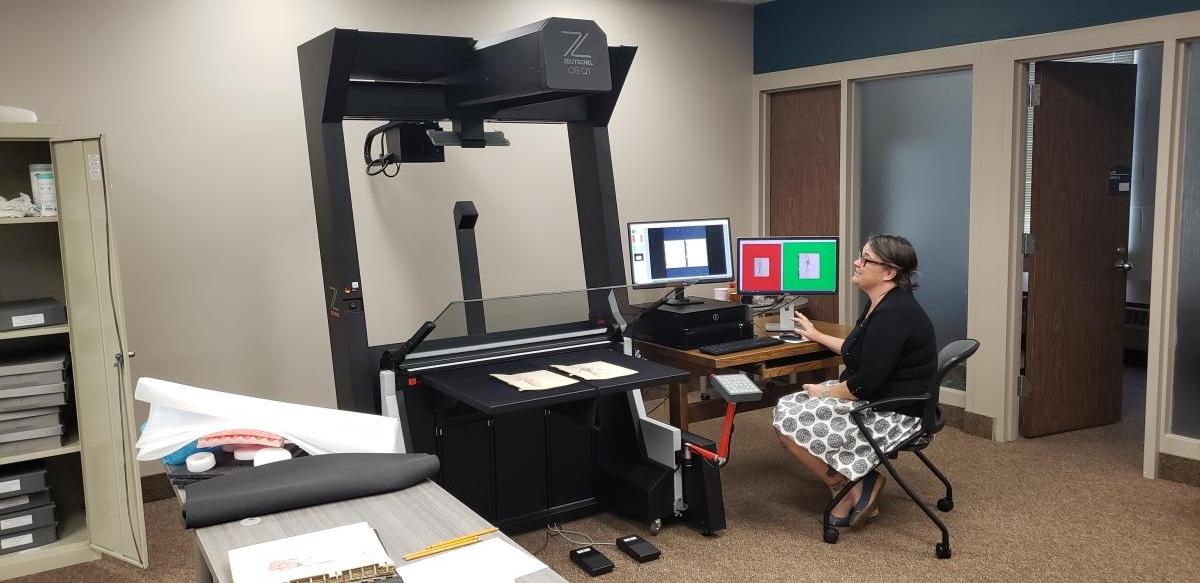New York couturi├©re designer Pauline Trig├©re, whose career spanned more than five decades, left behind a legacy of fashion innovation meticulously preserved in volumes of sketchbooks and press clippings.
Those volumes have had a home at since 1993 and soon will be accessible to everyone.

University Libraries received a Humanities Collections and Reference Resources grant from the for a project to digitize the entire Trige╠Ćre collection, which fills more than 10 feet of shelving in the library basement.
The project, ŌĆ£Pauline Trige╠Ćre: Fifty Years of American Fashion Entrepreneurship and Design,ŌĆØ is led by Digital Projects Librarian Virginia Dressler and Edith Serkownek, head of , which serves the students and faculty in ╠ņ╠ņ│į╣Ž StateŌĆÖs Shannon Rodgers and Jerry Silverman School of Fashion Design and Merchandising.

The grant, totaling $165,947, was used to purchase a high-resolution scanner and will pay the salaries of student workers to help with the digitization tasks over the next two years, Dressler said.
The new scanner recently was installed on the ninth floor of the University Library, and staff have been getting trained in how to use it.
ŌĆ£This has been called the Cadillac and Ferrari of scanners,ŌĆØ Dressler said. ŌĆ£ItŌĆÖs really a Ferrari because itŌĆÖs so fast.ŌĆØ
The scanner is so fast that Dressler has been able to scan one book in about 15 minutes, rather than the hour or longer that it previously would have taken.
Once this project is completed, Dressler said the scanner will be used for numerous other projects for digitizing library collections and rare books, so that they can be accessible online to anyone.
ŌĆ£There are so many ways this will be used on all kinds of projects,ŌĆØ she said.

Serkownek said many people are not familiar with Trige╠Ćre, a native of Paris who immigrated to the United States in 1937 with her family, to escape growing Nazi influence in Europe.
Their intent was to continue to South America, but instead, they remained in New York. The daughter of a tailor and dressmaker, Trige╠Ćre found work in New YorkŌĆÖs garment industry and by 1942 had started her own label.
Trige╠Ćre quickly found success and established herself as one of the countryŌĆÖs leading designers of womenŌĆÖs high-end, ready-to-wear fashion. For the next 50 years, her work would be sold in department stores and boutiques across the country and worn by many of AmericaŌĆÖs most prestigious women, including Grace Kelly, Jacqueline Kennedy Onassis, Elizabeth Taylor, Lena Horne, Angela Lansbury, Bette Davis.
Serkownek said Trige╠Ćre was successful at a time when many American designers were overlooked for their French counterparts, such as Dior and Chanel. But she capitalized on the American ready-to-wear market and became well known as a high-end designer, a step below couture.
ŌĆ£She ran her business here for 50 years and I think she represented the marriage of two things: the great American ingenuity of ready-to-wear with the sheen of a French tastemaker,ŌĆØ Serkownek said.
While her name is less well known today, Trige╠Ćre was a fashion force for more than 50 years, and broke many boundaries, Serkownek said.

In 1961, Trige╠Ćre hired Beverly Valdes as the first Black woman, to serve as a house model for a high-status fashion house in the United States; she also introduced the jumpsuit as a fashion staple for women in the 1960s.
Trige╠Ćre, who died in 2002 at age 93, was friends with Rodgers and Silverman, the namesakes of ╠ņ╠ņ│į╣ŽŌĆÖs fashion school, and visited campus in the 1990s, which is how she came to donate her materials to ╠ņ╠ņ│į╣Ž State. The ╠ņ╠ņ│į╣Ž Museum also is home to several Trige╠Ćre creations.

Serkownek said Trige╠Ćre designed her collections from fabric first, cutting and pinning the garment as she created, a technique she demonstrated in lectures at ╠ņ╠ņ│į╣Ž State. Trige╠Ćre then hired professional artists to make sketches of the dresses.
The collection includes 106 sketchbooks, and 226 scrapbooks of press clippings that show how her work was covered, promoted and perceived.
Dressler said the grant will pay for two part-time student workers to help with the scanning and entering its metadata. Students interested in the positions may apply by emailing Dressler with their interest at ; the job also will be posted to within the coming weeks.
ŌĆ£I applaud professors Dressler and Serkownek for their work. The Trige╠Ćre sketchbooks are hidden gems that our new scanner will enable us to digitize and share with the world, and itŌĆÖs just the beginning," said "The scanner is a foundational piece that will help us grow our support of digital scholarship in the years to come.ŌĆØ
The National Endowment for the Humanities supports research and learning in history, literature, philosophy, and other areas of the humanities by funding selected, peer-reviewed proposals from around the nation.

